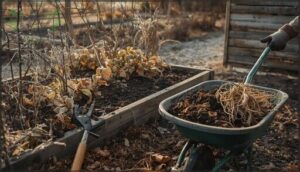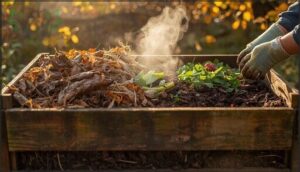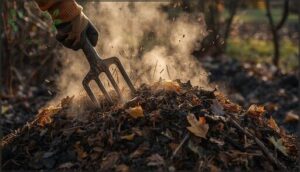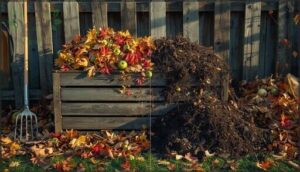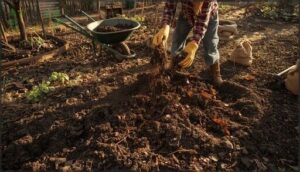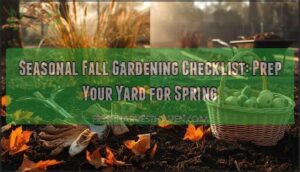This site is supported by our readers. We may earn a commission, at no cost to you, if you purchase through links.
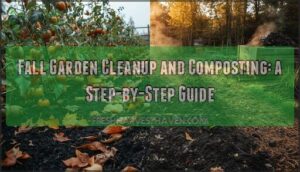
Your garden doesn’t shut down when the temperature drops—it shifts into preparation mode. Fall garden cleanup and composting transforms what looks like the end of the growing season into a strategic launch pad for next year’s success.
The difference between a garden that struggles through spring and one that explodes with vigor often comes down to what you do right now, before the ground freezes. Smart cleanup protects your soil from erosion, eliminates overwintering pests and diseases, and turns this year’s plant debris into next season’s fertility.
When you time your tasks with the first frost and build your compost pile with the right balance of materials, you’re not just tidying up—you’re investing in healthier plants, richer soil, and fewer problems come spring.
Table Of Contents
- Key Takeaways
- When to Start Fall Garden Cleanup
- Essential Fall Garden Cleanup Tasks
- Managing Fallen Leaves and Yard Debris
- Pruning and Protecting Trees and Shrubs
- Composting Techniques for Fall Materials
- Choosing The Right Compost Materials
- Preparing Soil for Winter and Spring
- Planting for Fall and Winter Success
- Cleaning and Storing Garden Tools
- Supporting Wildlife During Fall Cleanup
- Frequently Asked Questions (FAQs)
- Should you clean up your garden in the fall?
- Should you put compost on your garden in the fall?
- What should I do with my garden in the fall?
- When should fall cleanup be done?
- When should I stop watering my garden completely?
- How do I protect tender plants from frost?
- Can I plant bulbs during fall cleanup time?
- What tools work best for heavy garden cleanup?
- Should I fertilize before or after fall cleanup?
- Can I compost citrus peels and onion scraps?
- Conclusion
Key Takeaways
- Fall garden cleanup after the first frost eliminates overwintering pests and diseases while transforming plant debris into nutrient-rich compost that can boost soil organic matter by over 10% and reduce next season’s weed emergence by up to 90%.
- Strategic composting requires a 3:1 ratio of carbon-rich browns to nitrogen-rich greens, regular turning every three to four days during active decomposition, and strict exclusion of diseased plant material since backyard piles rarely reach the 131°F needed to kill pathogens.
- Leaving certain garden elements intact—like perennial seed heads and dead stems—provides critical winter habitat for pollinators and beneficial insects, with up to 50% of wild bees depending on this debris to survive until spring.
- Proper fall soil preparation through compost application, mulching with 2-4 inches of organic matter, and planting cover crops creates a foundation that reduces spring workload while increasing soil fertility and preventing erosion throughout winter.
When to Start Fall Garden Cleanup
Knowing when to begin your fall garden cleanup can make the difference between a smooth shift into winter and a last-minute scramble. The right timing protects your plants, preserves soil health, and sets you up for an easier spring.
Your cleanup schedule depends on three key factors: frost timing, plant types, and where you garden.
Timing After First Frost
After the first killing frost—when temperatures drop to 28°F for five straight hours—you’ll know it’s time to begin fall garden maintenance. In Zone 6a, frost dates usually fall between late October and early November, marking your seasonal shift.
Post frost cleanup protects winter soil prep by removing spent annuals, while your compost pile benefits from fresh garden debris. Cold weather composting works best when you’re preparing garden for winter right after frost date tracking confirms temperatures have dropped.
To boost your garden’s potential, consider creating a schedule to plan around last frost.
Identifying Annuals Vs. Perennials
Once you know your frost date, you’ll need to spot which plants to pull and which to leave standing. Your plant life cycles matter here—annuals like marigolds die after one season, while perennials such as hostas return each year. Check root system differences: taproots signal annuals bound for your compost pile, while spreading rhizomes mean perennials worth protecting. Growth habit clues and reproductive strategies help with botanical identification during fall cleanup. Understanding the plant life strategies is vital for distinguishing between annuals and perennials.
Three quick ways to tell them apart:
- Root inspection – Dig gently near the base; annuals show single taproots, perennials reveal woody crowns or bulbs
- Stem count – Multiple stems from one base usually indicate perennials; single stems suggest annuals
- Previous growth – Dead leaf bases around the plant signal perennial regrowth potential
Regional Climate Considerations
Your annual garden work depends on where you grow. Climate zones shift fall cleanup by weeks—northern gardeners face mid-October frosts while southern regions wait until late November or December.
Regional variations in weather patterns and seasonal shifts mean you’ll adjust your compost pile timing, soil health preparations, and winterization schedule.
Check USDA frost dates for your zone before planning fall cleanup activities and gardening for wildlife.
Essential Fall Garden Cleanup Tasks
Once the frost has done its work, it’s time to roll up your sleeves and tackle the essential tasks that will set your garden up for success. These aren’t complicated jobs, but they make all the difference in preventing disease, controlling weeds, and giving your soil a fighting chance over winter.
Let’s walk through the three core tasks every gardener should complete before the ground freezes.
Removing Spent Plants and Debris
Once the first hard frost signals dormancy, it’s time to clear your beds. Pull spent annuals completely—roots and all—to eliminate overwintering sites for pests like squash bugs and diseases such as early blight.
Healthy debris can fuel your compost pile, but discard any visibly diseased material separately. This simple garden sanitation practice protects soil health and sets the stage for a thriving spring.
Final Weeding for The Season
Discipline matters most regarding weed prevention. One final, thorough pass through your beds before the first frost can cut spring weed emergence by up to 60% and boost garden yield by nearly 20%. Target these problem spots:
- Winter annual weeds like henbit and purple deadnettle that thrive in cooler soil temperatures
- Taproot invaders such as Carolina geranium, easiest to pull when immature
- Perennial troublemakers relocating energy to roots
- Any weed threatening to populate your seed bank with 400,000 seeds per square meter
Manual removal beats herbicides for light infestations and pairs perfectly with fall cleanup. Pull weeds before adding garden debris to your compost pile, keeping diseased material separate. This strategic timing—when carbohydrate reserves make perennials vulnerable—protects your soil and reduces leaf litter issues come spring.
Clearing Vegetable Beds Safely
Pathogen control begins with complete debris removal from vegetable beds. Strip out all spent plants, decomposing roots, and mummified fruits—this soil sanitation cuts disease recurrence by 70% and slashes pest management headaches next spring.
Don’t compost visibly diseased material; dispose of it separately.
Your fall cleanup becomes disease prevention when you wash harvested produce thoroughly and mulch cleared beds immediately.
Managing Fallen Leaves and Yard Debris
Fall leaves and yard debris might seem like a hassle, but they’re actually free resources that can transform your garden. Instead of bagging everything up for the curb, you can put those materials to work improving your soil and protecting your beds.
Here’s how to handle the main types of yard debris you’ll encounter this season.
Collecting and Shredding Leaves
You’ll want to tackle leaf collection between late October and early November, before the first snow blankets your yard.
A lawnmower with a bagging attachment works wonders for shredding—it’ll reduce your leaf volume to just one-quarter of the original pile. This simple step speeds up composting and makes mulch creation more efficient, while also preventing those wet, matted layers that damage your lawn.
Using Leaves as Mulch or Compost
Leaf litter can work double duty in your garden. Spread shredded leaves 2–4 inches thick as mulch around perennials to suppress weeds by 80% and retain up to 27% more moisture.
For soil enrichment, pile them in your compost bin where leaf decomposition creates nutrient-rich material supplying 35+ pounds of calcium, magnesium, and potassium per 1,000 square feet while supporting carbon sequestration.
Recycling Large Branches and Trimmings
Branch recycling diverts over 22 million tons of yard waste from landfills annually while creating valuable wood chip mulch for your garden. Cut tree debris into 3–4 foot sections and take them to municipal drop-off centers, where commercial chippers reduce volume by 70%.
This fall yard cleanup strategy transforms waste into compost creation material, saving municipalities $23 per ton in processing costs.
Pruning and Protecting Trees and Shrubs
Your trees and shrubs need a little attention before winter sets in. Fall is the right time to remove damaged wood, shape your plants for healthy growth, and give young trees the support they need to survive cold weather.
Here’s how to approach each task with confidence.
Trimming Dead or Diseased Branches
Late fall is your best window for inspecting tree branches and removing dead or diseased wood—a vital step in fall garden cleanup that reduces winter disease spread by up to 60%. Walk your yard after leaf drop to spot problem areas clearly:
- Cut diseased branches at least 8 inches below visible damage
- Sterilize your pruning tools between cuts using diluted bleach
- Focus on opening the canopy for better airflow and sunlight penetration
Proper Techniques for Shrub Pruning
While removing damaged branches protects trees, your shrubs need a different approach during fall garden cleanup. Never remove more than one-third of the crown in a single season—exceeding this triggers plant stress and weakens vigor.
Use thinning cuts rather than shearing to maintain natural form, and time your pruning schedules carefully: spring bloomers get trimmed after flowering, while summer varieties benefit from late-winter attention. When using proper cutting techniques with sharp pruning tools, you encourage denser branching and support shrub renewal.
Preparing Young Trees for Winter
While mature shrubs withstand cold, young trees need dedicated winter watering and frost prevention. Protect their thin bark with tree trunk protection wraps at least 36 inches high, and apply 2-4 inches of compost pile material around root zones for soil insulation. Install animal guards before snow flies, and water deeply one last time before ground freeze—evergreens especially suffer from winter desiccation.
- Wrap vulnerable trunks to prevent sunscald cracking
- Mulch root zones to retain precious moisture
- Install tall barriers against hungry wildlife
- Water deeply before the ground freezes solid
- Monitor thin-barked species throughout winter
Composting Techniques for Fall Materials
Fall is prime time to build a nutrient-rich compost pile that’ll be ready to feed your garden come spring. The key to success lies in understanding a few core techniques that transform yard waste into black gold.
Here’s how to compost effectively using the abundance of fall materials at your disposal.
Balancing Browns and Greens
Success in composting depends on getting your carbon balance right. You’ll want roughly three parts brown sources—like shredded leaves and straw—to one part green materials such as kitchen scraps and fresh plant debris.
This compost ratio fosters microbial growth and healthy decomposition during your fall garden cleanup. When the mix feels right, your pile will heat up within days, transforming debris into rich compost for soil care and management.
Turning and Aerating The Pile
Once your browns and greens are mixed, regular pile aeration keeps the composting process humming. Turn your compost every three to four days during active thermophilic phases to replenish oxygen levels and maintain microbial activity. This practice prevents anaerobic pockets and speeds decomposition, transforming fall debris into nutrient-rich soil amendments.
- Watch for temperatures nearing 160°F—that’s your signal to turn
- Use a pitchfork to move outer material toward the center
- Expect a temperature drop, then renewed heat as microbes reactivate
- Monitor moisture while aerating; the pile should feel like a wrung-out sponge
Avoiding Diseased Plant Material
One careless toss of infected stems can undermine months of effort. Over 25% of garden debris harbors pathogens like Fusarium and Alternaria, and most backyard piles never reach the 131°F needed for pathogen control. For reliable disease prevention and compost safety, bag and discard questionable material—don’t risk next season’s harvest on guesswork.
| Material Type | Compost or Discard? | Reason |
|---|---|---|
| Healthy plant stems | Compost | Safe; no disease risk |
| Powdery mildew leaves | Discard | Spores survive cold piles |
| Tomato blight debris | Discard | Pathogens persist 18+ months |
| Insect-damaged foliage | Compost (if no disease) | Insects alone aren’t contagious |
| Mummified fruit | Discard | High pathogen load |
Choosing The Right Compost Materials
Not everything belongs in your compost pile, and knowing what to add—or avoid—makes all the difference in creating nutrient-rich material for your garden. The right mix breaks down quickly and feeds your soil, while the wrong ingredients can invite pests, spread disease, or slow the whole process to a crawl.
Here’s what you should toss in and what you need to keep out.
Using Garden Debris and Vegetable Scraps
Your compost pile thrives on a mix of garden debris and vegetable scraps—together, they create organic matter that drives soil enrichment and waste reduction. Food scraps deliver nitrogen for decomposition, while plant trimmings add carbon sequestration potential.
This eco-friendly practice diverts material from landfills, boosts compost quality, and transforms your fall garden cleanup into a resource for healthier, more resilient soil.
Incorporating Fall Leaves and Straw
Fall leaves and straw are powerhouse additions for leaf composting and straw mulching during fall soil prep. Their high carbon content—usually 40:1 to 80:1—balances nitrogen-rich greens, supporting microbial balance and carbon sequestration.
Shred leaves before adding them to your compost pile; this simple step accelerates decomposition and transforms leaf litter into valuable organic matter. Your fall garden cleanup becomes garden maintenance that feeds next season’s success.
Excluding Weeds and Invasive Species
You’ll want to keep weeds and invasive species out of your compost pile—standard composting rarely hits the sustained 140°F needed for complete seed eradication. Even high-performing piles leave 10% of seeds viable, risking reinfestation.
Bag flowering weeds separately, let them rot in sunlight, then discard. This weed exclusion safeguards compost safety and protects your sustainable gardening practices during fall garden cleanup.
Preparing Soil for Winter and Spring
Your soil has worked hard all season, and now it’s time to give back. Fall is the perfect window to rebuild fertility and set the stage for a strong start come spring.
Here’s how to prep your beds so they’re ready to thrive when the ground thaws.
Adding Compost and Organic Matter
Think of your garden soil as a living bank account—deposits made now pay dividends all spring. Adding organic matter in fall enriches your garden soil by boosting microbial growth and improving soil structure.
A soil test reveals exactly what nutrients you need. Spread one to three inches of compost across your beds, mixing it into the top six inches for maximum nutrient cycling and long-term composting and soil health benefits.
Mulching Beds for Protection
A well-timed mulch layer acts like a winter blanket for your garden soil, locking in moisture and moderating temperature swings. Apply 2-4 inches after the first hard frost for ideal soil insulation and freeze prevention.
- Use shredded leaves, pine bark, or straw as effective mulch materials
- Keep mulch away from plant stems to prevent rot
- Cover beds completely for consistent winter protection
- Deeper layers (4-6 inches) suit newly established perennials
- Perform a soil test before mulching to guide compost additions
This simple step reduces spring weeds by up to 90% while protecting roots from damaging freeze-thaw cycles.
Planting for Fall and Winter Success
Fall isn’t just about clearing out—it’s also one of the best times to set your garden up for success in the months ahead. From enriching your soil with cover crops to getting cold-hardy plants in the ground, these strategic plantings do the heavy lifting while you rest.
Here’s what you can tackle now to wake up to a healthier, more productive garden come spring.
Sowing Cover Crops
Cover crops transform bare soil into a living system. After fall garden cleanup and your final compost application, choose winter-hardy species like winter rye or annual ryegrass for your vegetable gardening rotation.
Sow by mid-October when soil preparation is complete—earlier planting means stronger stands. Increase seeding rates by 20% to 50% for late sowings.
This sustainable gardening practice rebuilds soil while suppressing weeds naturally.
Planting Garlic and Overwintering Vegetables
After your cover crops are in, plant garlic cloves 4–5 inches deep with pointed ends up, spacing them 6 inches apart. Choose hardneck garlic varieties for colder zones (3–6) or softneck types for milder climates.
Pair this fall garden cleanup task with overwintering vegetables like spinach, kale, and onions—hardy crops that tolerate heavy frost and reward you with early spring harvests through smart crop rotation.
Creating New Garden Beds With Sheet Mulching
Sheet mulching turns lawn or weeds into productive garden beds without the backbreaking work of tilling. Lay down overlapping cardboard directly on grass, then pile 3–6 inches of compost, leaves, or straw on top. This weed suppression technique enriches soil fertility while recycling organic matter—perfect for gardening for beginners tackling fall garden cleanup with minimal effort.
- Reduces weed emergence by 95% in your first season
- Increases soil organic matter by 6–12% within one year
- Cuts irrigation needs by 30–50% compared to bare soil
- Converts problem lawn areas into productive beds in one season
- Recycles 450–900 pounds of cardboard per 1,000 square feet
Cleaning and Storing Garden Tools
Your garden tools have worked hard all season, and they deserve a little care before winter sets in. Taking time now to clean, disinfect, and properly store your equipment will extend its lifespan and prevent rust, disease, and costly replacements.
Here’s how to give your tools the attention they need before the cold arrives.
Washing and Disinfecting Tools
You can’t see the tiny pathogens hiding on your tools, but they’re there—waiting to spread disease to healthy plants. Start your tool sanitation routine by scrubbing off all visible dirt with a stiff brush; debris reduces disinfectant effectiveness by up to 85%.
Then, choose your cleaning method: a 10% bleach solution, 70% isopropyl alcohol, or Lysol spray all achieve excellent pathogen removal. Proper garden hygiene protects your investment and prevents recurring infections.
Oiling and Proper Storage
Rust prevention begins with proper oil application—use boiled linseed oil on both metal blades and wooden grips once or twice per season to extend tool life by up to three years. This simple tool maintenance step reduces corrosion by 45–60% and prevents grip cracking.
Storage techniques matter too: keep your gardening tool management system organized in dry toolboxes or on pegboards where ventilation prevents moisture damage and grip protection remains effective.
Winterizing Irrigation and Water Systems
Before freezing temperatures arrive, you’ll want to protect your irrigation systems from costly damage. Water expansion during freezing can burst pipes and crack components, making winterization essential for effective freeze damage prevention.
Professional winterization costs average $85 annually—a smart investment in irrigation system maintenance compared to potential spring repairs running into thousands:
- Drain all water lines, sprinkler heads, and drip irrigation components completely
- Blow out remaining water using compressed air for thorough pipe insulation methods
- Insulate or remove above-ground valves and backflow devices
- Shut off main water supply to water-efficient irrigation systems and soaker hoses
- Disconnect and store timers to support water conservation strategies
This winterization and snow preparation routine extends system lifespan by five years while boosting next-season efficiency by 25%.
Supporting Wildlife During Fall Cleanup
Your fall cleanup doesn’t have to mean clearing everything away. A few simple choices can transform your garden into a winter refuge for birds, insects, and small mammals that help keep your ecosystem thriving.
Here’s how to balance a tidy space with wildlife-friendly practices.
Leaving Seed Heads for Birds
Before you reach for those pruners, consider this: one sunflower head produces up to 2,000 seeds, enough to fuel dozens of chickadees through winter’s harshest days.
Leaving seed heads from native plants creates essential bird seed sources that support avian nutrition when natural food becomes scarce.
This simple wildlife conservation practice transforms your garden cleanup into a lifeline, with diverse seed heads attracting up to nine different species while enriching your ecosystem.
Creating Brush Piles for Shelter
Think of brush pile construction as building a wildlife hotel from your fall prunings. Stack large logs as the base—12 to 20 inches in diameter—then layer smaller branches on top to create a structure 12 to 18 feet wide and 3 to 6 feet high.
This eco-friendly material provides vital small mammal shelter and aids winter survival strategies, hosting 2 to 7 times more animals than sites without this simple wildlife habitat creation.
Maintaining Habitat for Beneficial Insects
Your fall cleanup choices directly shape insect populations: 30% to 50% of wild bees overwinter in dead stems and leaf litter.
Fall cleanup decisions have real consequences: up to half of wild bees depend on dead stems and leaf litter to survive winter
Leave perennials standing until late spring to protect pollinators and natural pest predators.
This eco-friendly gardening approach delivers $20 billion in ecosystem services annually through pollination and pest control while supporting biodiversity and wildlife habitat creation with beneficial bug habitat and insect-friendly plants.
Frequently Asked Questions (FAQs)
Should you clean up your garden in the fall?
Yes, a thorough fall garden cleanup is worth your effort. Removing spent plants and debris cuts pest populations by 25% and slashes fungal disease recurrence up to 45% next spring, laying the groundwork for healthier growth.
Should you put compost on your garden in the fall?
Absolutely—applying compost in fall boosts soil organic matter by over 10% and increases nitrogen levels dramatically. This timing allows nutrients to integrate naturally over winter, setting your garden up for vigorous spring growth and healthier plants.
What should I do with my garden in the fall?
Your autumn to-do list includes clearing spent plants, weeding, enriching soil with compost, planting cover crops or garlic, mulching beds, storing tools, and planning crop rotation—all essential for winter preparation and garden renewal.
When should fall cleanup be done?
Start your seasonal gardening tasks after the first frost, usually from early to mid-fall depending on your region. This weather watch approach ensures proper timing for cleanup scheduling while protecting plants before freezing temperatures arrive.
When should I stop watering my garden completely?
Stop watering when daytime temperatures consistently drop below 50°F or nighttime lows hit 30°F—usually late October through November.
Once the ground freezes, your plants can’t absorb moisture anyway, signaling complete dormancy stages.
How do I protect tender plants from frost?
When frost threatens, cover tender plants with frost blankets or garden fleece before temperatures drop to 0°C. Layer mulch around roots and water soil beforehand—these steps prevent freeze damage effectively.
Can I plant bulbs during fall cleanup time?
Yes, fall garden cleanup is the perfect time to plant bulbs. Aim for soil temperatures between 50–55°F, usually October through November.
Plant tulips, daffodils, and crocus at three times their height for ideal timing and spring success.
What tools work best for heavy garden cleanup?
Like clearing the Augean stables, heavy garden cleanup demands the right arsenal. Power equipment like leaf blowers and mulching machines handle volume fast, while hand tools—rakes, wheelbarrows, and ergonomic gear—tackle detail work safely.
Should I fertilize before or after fall cleanup?
Fertilize after fall cleanup for better nutrient uptake. Clearing debris first ensures direct soil contact, preventing up to 40% nitrogen loss from runoff and maximizing fertilizer efficiency.
This practice also supports healthier spring growth through improved soil microbial activity.
Can I compost citrus peels and onion scraps?
You can compost citrus peels and onion scraps, but chop them small and mix with carbon-rich materials.
Balance compost ratios carefully—too much citrus or onion disrupts microbe balance and slows decomposition.
Conclusion
Fall garden cleanup and composting may feel like extra work when you’d rather retreat indoors, but these hours invest directly in easier gardening next year.
The plant debris you compost today becomes the fertility that feeds your tomatoes in July. The beds you mulch now resist weeds and erosion through spring.
Your garden’s future productivity lives in the choices you make this season—every task completed now means one less problem waiting for you later.
- https://www.waste360.com/yard-waste/profiles-in-garbage-yard-waste-10847
- https://bullytools.com/news/seasonal-garden-cleanup-fall-vs-spring/
- https://www.thesalemnewsonline.com/news/article_4b0a96a7-e465-53b2-b792-6cc15d6cfa96.html
- https://extension.illinois.edu/news-releases/fall-garden-cleanup-lays-groundwork-successful-spring
- https://drawdown.org/explorer/increase-centralized-composting

